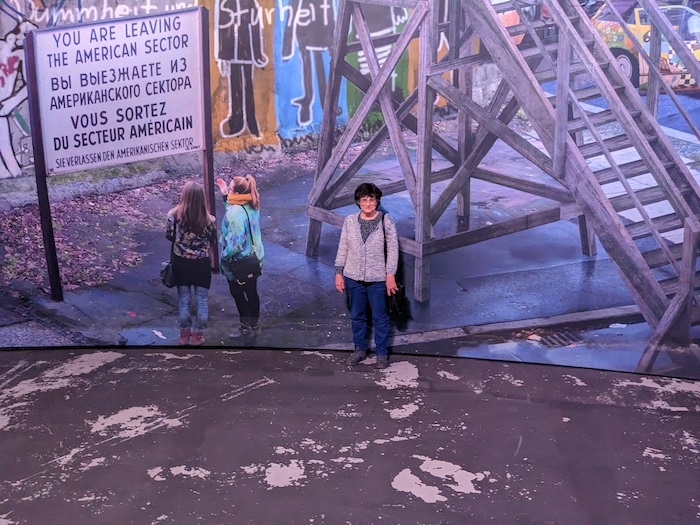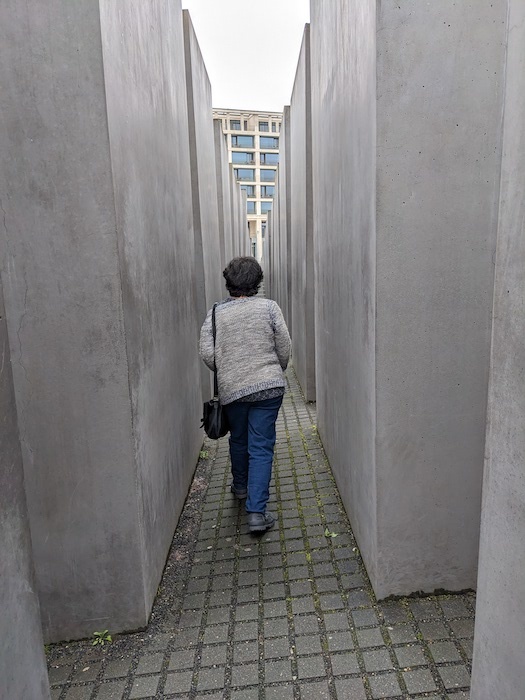May. 26th, 2023 09:17 pm
Germany, Saturday
I’ve always liked spy novels set in Berlin during the Cold War, and being there makes me wonder what it had been like living in a divided city. There are very few signs of the old East Berlin, though, some Stalinist buildings, outdoor exhibits with old photos, a few goofy-looking Trabant cars that had been manufactured in East Germany. We go to a large panorama showing what the Wall had looked like, painted by the artist Yadegar Asisi. It’s well done, so much so you almost feel as if you’re there. I’d thought the Wall would have been at the forefront of everyone’s mind, a constant presence, but someone is quoted in the exhibit as saying that people in West Berlin rarely thought about it.

This isn't the actual Wall, but it's cool nonetheless
We walk to the Brandenburg Gate, to the Reichstag (just the outside, you need a reservation for an inside tour), to Tiergarten park. The Gate is crowded but the park is almost deserted, a refuge from the bustling city a few feet away.


Then we go to the Memorial to the Murdered Jews of Europe. It’s made up of concrete blocks of varying sizes, a strange construction that seems more like a children’s playground than a reminder of genocide. As you walk down the rows people appear and disappear, and I wondered if that was the point of it, if you were supposed to be reminded of those who had vanished.

I look up the Memorial when we get back to the hotel. The artist had said that “the stelae [concrete blocks] are designed to produce an uneasy, confusing atmosphere, and the whole sculpture aims to represent a supposedly ordered system that had lost touch with human reason.” Well, OK, but why no mention of the Holocaust at all? Why is the name so coy, with no explanation of who did the actual murdering? (There is a small museum that gives some history.) Then I read that the company that made the anti-graffiti coating for the stones had a subsidiary that had produced the Zyklon B gas used in concentration camps. This had come up during the construction of the memorial, but too many stones had been covered to start over. But why hadn’t anyone researched the company before?
While we were there a woman tripped and nearly fell over a low concrete block in the dimly lit museum. OK, that wasn’t as heinous as the memorial’s other failings, but the whole thing seemed very clumsy.
I’m sorry I couldn’t like the memorial. Germany has done some amazing things to make amends for its crimes: it paid restitution for slave labor and ill health caused by the camps; its schools make sure the students learn about the Holocaust; it offers citizenship to the descendants of people who were disenfranchised by the Nuremberg Laws — with the ironic result that my brother and I are now German citizens. It has laws against hate speech, and while I used to think this was a slippery slope toward censorship, I start to see their point whenever I visit the creepier parts of the internet. In some ways Germany even does better than the US — by teaching the unvarnished truth of its history, for example, and by paying reparations.
My mother had vowed never to set foot in Germany, and, not really thinking about it all that much, I had done the same thing. It was because of all these changes that I reconsidered. (“I can’t believe you’re going to Germany,” several Jewish friends said.) So what went wrong with the memorial? Is it just that it’s impossible to portray the Holocaust at all meaningfully?

This isn't the actual Wall, but it's cool nonetheless
We walk to the Brandenburg Gate, to the Reichstag (just the outside, you need a reservation for an inside tour), to Tiergarten park. The Gate is crowded but the park is almost deserted, a refuge from the bustling city a few feet away.


Then we go to the Memorial to the Murdered Jews of Europe. It’s made up of concrete blocks of varying sizes, a strange construction that seems more like a children’s playground than a reminder of genocide. As you walk down the rows people appear and disappear, and I wondered if that was the point of it, if you were supposed to be reminded of those who had vanished.

I look up the Memorial when we get back to the hotel. The artist had said that “the stelae [concrete blocks] are designed to produce an uneasy, confusing atmosphere, and the whole sculpture aims to represent a supposedly ordered system that had lost touch with human reason.” Well, OK, but why no mention of the Holocaust at all? Why is the name so coy, with no explanation of who did the actual murdering? (There is a small museum that gives some history.) Then I read that the company that made the anti-graffiti coating for the stones had a subsidiary that had produced the Zyklon B gas used in concentration camps. This had come up during the construction of the memorial, but too many stones had been covered to start over. But why hadn’t anyone researched the company before?
While we were there a woman tripped and nearly fell over a low concrete block in the dimly lit museum. OK, that wasn’t as heinous as the memorial’s other failings, but the whole thing seemed very clumsy.
I’m sorry I couldn’t like the memorial. Germany has done some amazing things to make amends for its crimes: it paid restitution for slave labor and ill health caused by the camps; its schools make sure the students learn about the Holocaust; it offers citizenship to the descendants of people who were disenfranchised by the Nuremberg Laws — with the ironic result that my brother and I are now German citizens. It has laws against hate speech, and while I used to think this was a slippery slope toward censorship, I start to see their point whenever I visit the creepier parts of the internet. In some ways Germany even does better than the US — by teaching the unvarnished truth of its history, for example, and by paying reparations.
My mother had vowed never to set foot in Germany, and, not really thinking about it all that much, I had done the same thing. It was because of all these changes that I reconsidered. (“I can’t believe you’re going to Germany,” several Jewish friends said.) So what went wrong with the memorial? Is it just that it’s impossible to portray the Holocaust at all meaningfully?